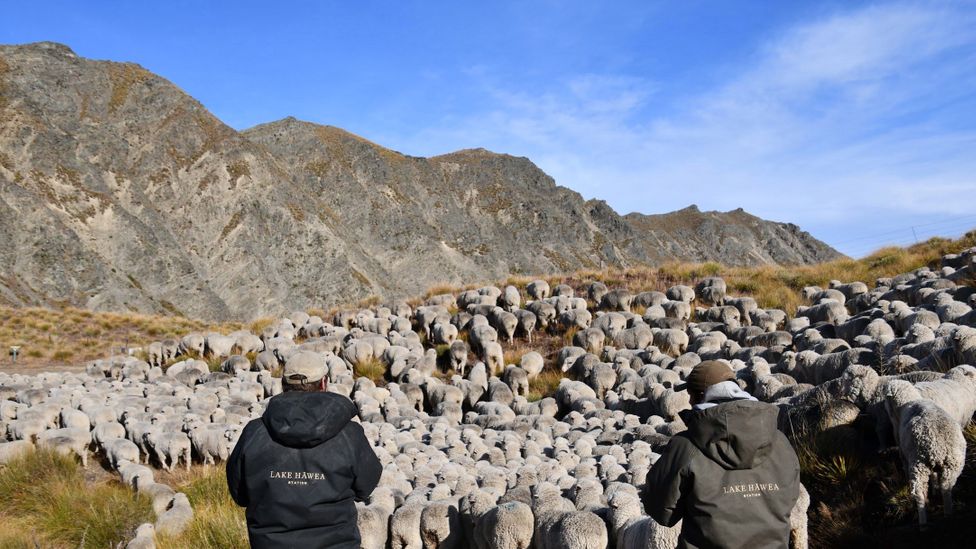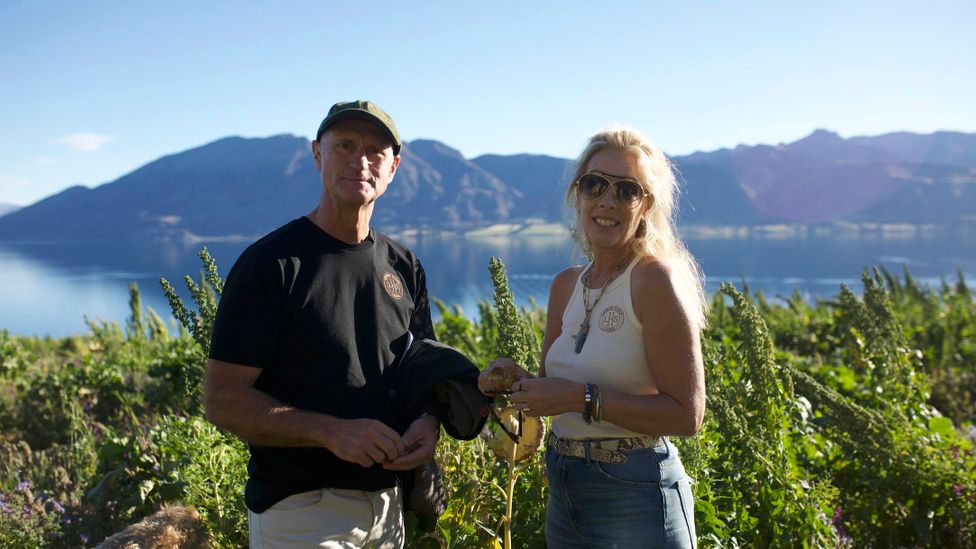While building their fledgling fashion brand, environmentally minded Edzard van der Wyck and Michael Wessely confronted a deluge of sustainability claims about different textiles.
"We looked at all types of fibres from cashmere to pineapple skin," says Wessely. But they often found barriers in the way materials were produced. Bamboo, for example, while biodegradable, often goes through intensive chemical manufacturing processes. Pineapple production typically uses large amounts of agrochemicals and is usually grown in monoculture.
They were looking for a fabric with sustainability credentials that stood up to scrutiny, not just in carbon emissions but also in its impact on biodiversity, pollution, recyclability and the communities producing it. They initially suspected the ideal fabric might be found on the more innovative end of the spectrum, exploring materials that were relatively new to fashion.
But in 2018, Van der Wyck and Wessely turned their attention to a much, much older material. They met regenerative sheep farmers who "wanted to bring about radical change" to their industry, Wessely says. Impressed with farmers' convictions and the technical and environmental benefits they claimed their produce offered, they landed on their raw material of choice: regenerative wool. "The real answer came in the form of an ancient material, albeit sourced and treated in a pioneering way," says Wessely.
A year later, they established Sheep Inc, which claims to be the world's first "carbon negative" fashion brand. The London-based brand factors farming (including methane, sheep farming's main source of emissions), manufacturing, packaging and transport into its analysis, according to a report from independent certifiers, Carbon Footprint. However, this figure doesn't include home energy emissions from the team's remote working nor other digital emissions, although these would likely be low compared to emissions from farming wool.
Sheep Inc's methods to keep its environmental impact low include using solar-powered knitting machines, sorting clothes in a solar-powered warehouse and a plastic-free supply chain. Customers can also return items to Sheep Inc for mending and repair.
Experts in sustainable fashion have praised the company's efforts. "This is a brand after my own heart: championing regenerative natural fibres, renewable energy, responsible production with a fully traceable supply chain," says independent sustainable fashion consultant Lucianne Tonti. "They are proof of the concept that it is possible to make beautiful clothes with a positive environmental impact."
The fashion industry is responsible for between 8 and 10% of global greenhouse gas emissions, more than aviation and shipping combined.
Some 70% of fashion's emissions come from its supply chains, concentrated in raw material production, processing and preparation. This was why carefully selecting raw material suppliers was so crucial to Sheep Inc's process, says Wessely.

Advocates say the diversity of plant, microbe and animal life can be improved on regenerative farms (Credit: Lake Hāwea Station)
Wool is viewed as somewhat of a wonder-fabric in the fashion industry because it is hardier than most fibres, requires less washing, and is recyclable, Tonti says. "It's strong, elastic and has a waxy coating so it doesn't stain easily, and it's odour resistant." It is also flame-retardant, has anti-bacterial properties, and can absorb up to 30% of its weight in water, she says. When wool returns to soil or water, it biodegrades, unlike petroleum-based fabrics such as polyester. (Read more about fashion's colossal waste problem).
This makes it a strong contender for sustainable clothing that lasts consumers decades. But conventional wool production remains far from climate-friendly; sheep emit methane, which is 28-36 times more potent than CO2 over a 100-year period. Conventional wool farming often uses set stock grazing, where animals sit in the same paddocks for long periods which can lead to desertification, biodiversity loss and soil erosion.
In places like South America, New Zealand and Australia, it is more common for sheep to roam but chemical fertilisers are commonplace and without adaptive management practices, conventional sheep farming can lead to the same overgrazing issues as set stock grazing including water pollution, soil erosion and desertification.
You might also like:
- The vegan leather made from India’s waste flowers
- Why you need a 'wellbeing wardrobe'
- Can clothes ever be fully recycled?
Sheep Inc's founders say their regenerative farming practice can help make fashion more sustainable, and even help absorb more carbon from the atmosphere than is released during farming, making the practice carbon negative. The firm is part of a small movement of brands such as Stella McCartney and A New Sweden who are adopting these practices for their wool.
The regenerative approach seeks to replicate what happens in the wild, where animals roam as they graze to find new sources of food and avoid predators, allowing grasslands to heal. Fertilisation from the sheep's manure means there is little need for synthetic fertilisers. Unused paddocks are rewilded, and there is no tillage. The company sources its merino wool from Lake Hāwea Station, which was named New Zealand's first "carbon negative" farm in 2019 by carbon footprint certifiers Toitū.
Running on renewable energy, the farm claims to have turned itself into a carbon sink by pulling emissions from the atmosphere through native forest restoration. Lake Haweā Station's most recent report says 4,958 tonnes of CO2 equivalent (CO2e) were sequestered from 2019 to 2020. With 2,538 tonnes of CO2e per year emitted from the farm (78% of which is methane), it says this results in a net carbon sink figure of 2,420 tonnes CO2e – equivalent to taking over 500 cars off the road. The farm says that additional carbon is also sequestered through soil regeneration, which scientists say has significant carbon sequestration potential, but due to New Zealand's carbon accounting stipulations, soil does not yet factor into its calculations.
Gwen Grelet, an ecologist and senior researcher at Manaaki Whenua (Landcare Research), a New Zealand government research institute, recently conducted a white paper on regenerative agriculture in New Zealand. She feels the efforts of Lake Hāwea Station are "truly regenerative". "What is extraordinary is that wool production is done in such a way that it supports the restoration of native biodiversity," she says. "If all wool was produced regeneratively, it could make a big difference for the climate, because vast areas of land currently support sheep grazing."

Sheep farmers at Lake Hāwea Station darm in New Zealand use rotational grazing to reduce the livestock’s environmental impact on paddocks (Credit: Lake Hāwea Station)
Sheep Inc claims that the absorption of CO2 via regenerative farming of its products more than cancels out the warming impact of the methane emissions from the sheep on these farms. Whereas 1kg (35oz) of conventionally sourced wool might release over 25 kg of CO2e emissions, Sheep Inc says its wool on average leads to the sequestration of 14kg CO2e.
It's not the only company making such claims. A 2020 Australian pilot study conducted by the marketing body for the wool industry, Woolmark, says 11 small and medium-sized farms involved in regenerative wool practices sequesters an overall 1,539 tonnes of CO2e per year after other emissions have been taken into account, maintaining 80% ground cover over 13 years.
Alongide the potential for capturing CO2 using regenerative practices, Grelet adds that preliminary evidence suggests they may also reduce the emissions of methane itself from sheep farming, through methane capture in soils or reduction of methane emissions from sheep. However, alone these reductions of methane are "likely not enough to counter methane emissions by sheep", she adds.
Studies have found regenerative wool has the potential to sequester carbon from the atmosphere, mitigating the effects of climate change. However, more robust scientific research is needed to fully understand the potential of regenerative wool to reduce emissions.
Regenerative wool's proponents argue it can also increase soil resilience (which can protect against drought and flooding) and reduce reliance on superphosphates, a type of fertiliser that can be toxic to animals and contributes to carbon emissions). By fostering biodiverse ecosystems of plants, animals and microbes, regenerative agriculture also helps aid water and soil conservation. And regenerative farming may also show improved economic outcomes for farmers when natural capital is accounted for.
Lake Hāwea Station is home to 20,000 trees and 300 wildlife species, including 10 endemic and eight native birds. "Some of the seed mixes going into our pastures have up to 30 seeds in them," says farm owner Geoff Ross. "That means more life above ground. The general view is more life above ground means more below it." On a regenerative wool farm, soil hosts rich communities of microbes resulting in healthier animals (and healthier manure) which means less need for imported feed, says Grelet.
As companies look to improve sustainability credentials, more firms are turning to regenerative farming. US fashion giant Allbirds sources a portion of its wool from Lake Hāwea Station, with plans for all wool to be regeneratively sourced by 2025. Activewear brand Patagonia traces its woollen apparel to regenerative ranches and haute couture brands including Stella McCartney, Gucci and Edward Crutchley are all embracing the textile. In the UK, high-street retailers such as Marks & Spencer are also considering the sustainability of their wool.
Most adopters, however, remain luxury brands and items come at a price – a Sheep Inc hoodie will set you back £180 ($222) and an Allbirds sweater costs around £108 ($133).
"The mass market is not adopting regenerative wool yet," says Peter Ackroyd, chief operating officer of the non-profit Campaign For Wool. "It's buying cheap fibre… and selling at low prices." This makes it hard to predict whether regenerative wool will stay a luxury, he says, with the fast fashion industry unlikely to adapt in the short or medium term. Though prices may come down if the upper-middle fashion sector embraces regenerative farming, he adds.

Geoff and Justine Ross run Lake Hāwea Station in New Zealand with their children (Credit: Lake Hāwea Station)
Regenerative farming could be used for other products used in the fashion industry – such as cotton or perhaps even pineapple. Yet regenerative farming has downsides which may put off brands or limit its widespread use across the fashion industry. The agricultural practice likely needs more labour and land, and might be more expensive than conventional methods per tonne of products such as wool, meat, milk, grains or vegetables, says Grelet – at least if current standard economic metrics are used that do not account for the financial repercussions of biodiversity and soil losses or water pollution.
Tonti says even where regenerative wool is adopted, fashion companies must ensure their sustainability claims are thoroughly researched and backed up by evidence. In 2022, Allbirds faced a lawsuit that alleged its carbon footprint estimate for shoes made using wool was inaccurate – the lawsuit was dismissed by a New York court. Allbirds tells the BBC it "takes great care in describing our approach to sustainability".
Woolmark has also faced claims that its advertisements for sustainable wool are misleading. Woolmark told the BBC it takes allegations about greenwashing very seriously and invests in "robust research to investigate ways for the Australian wool industry to reduce its environmental impact" including by reducing and offsetting methane emissions.
Carbon Count
The emissions from travel it took to report this story were 0kg CO2. The digital emissions from this story are an estimated 1.2g to 3.6g CO2 per page view. Find out more about how we calculated this figure here.
Challenges in traceability and mixing wool with synthetics, as well as the use of chemical dyes make the issue thornier, says Tonti. Sheep Inc currently uses Bluesign certified dyes (which considers factors like water use and air emissions) but says it is launching a new, traceable dyeing method this summer. Yet the company has no plans to alter its method of international shipping, which Tonti questions. Van der Wyck says that overall, shipping regenerative wool from New Zealand leads to lower emissions than if the company sourced regenerative raw materials in Europe.
Ultimately, says Grelet, for regenerative wool to revolutionise fashion's footprint, the regenerative approach needs to be applied at all levels of the industry, including by consumers "making wiser purchase choices and buying fewer garments", and by adequate recycling being made available to minimise waste. A 2022 survey of 5,900 fashion consumers found that while 65% of shoppers care about sustainability only 15% of those surveyed say they prioritise it when shopping.
Wool may make up just 1% of the global fibre market but Tonti calls it, "a great test fibre for the rest of regenerative agriculture, and in proving we can have visibility from garment all the way back to the farm.
"With a bit of extra leg work and asking the right questions of suppliers it is possible for other companies to follow Sheep Inc's lead," she says.
--
Join one million Future fans by liking us on Facebook, or follow us on Twitter or Instagram.
If you liked this story, sign up for the weekly bbc.com features newsletter, called "The Essential List" – a handpicked selection of stories from BBC Future, Culture, Worklife, Travel and Reel delivered to your inbox every Friday.
Can regenerative wool make fashion more sustainable? - bbc.com
Read More

No comments:
Post a Comment